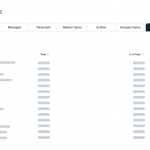Don’t Drop the Omni-Channel Baton and Win the CX Relay Race
Don’t Drop the Omni-Channel Baton and Win the CX Relay Race

Managing the hand-over from bot to agent is like taking part in a relay race. However, just as in any relay the secret is not to drop the baton. Here are 3 winning strategies for a seamless customer experience that will take you over the finish line in a record-breaking way.
The ability for customers to self-serve successfully is increasing steadily, in line with technological advances, but there is a long way to go before we can even begin to contemplate an exclusive reliance on such tools. Meanwhile, leading research organizations are consistent in their opinion and predictions that the number of agents worldwide will not change dramatically over the next few years which means agents and bots need to coexist for the foreseeable future.
Realistically, I believe the challenge for most contact centers will be managing the transition from self-service to assisted service, when an agent takes over from a bot’s failed attempt to resolve the customer interaction. It reminds me of a relay race where one of the runners is a chatbot and passes the ‘experience baton’ onto an agent to complete the final leg and win the race.

The ‘Experience Baton’ Challenge
With this image in mind, I foresee 4 likely scenarios in the relay race and yet only one promises the record-breaking outcome everyone is looking for:
The Chatbot Stumbles
In this scenario, the agent doesn’t even get to speak to the customer because the chatbot has failed so dismally, that the customer abandons the interaction. We can all recite horror stories where chatbots send us around in infinite loops with seemingly no ability or interest in actually helping us with even the simplest tasks. The trouble is these kinds of frustrating experiences are bad for business because they are a key driver of brand defection. While many people will give you a second chance, an astonishing 3 in 5 consumers say they’ve switched brands due to negative contact center experiences.
Dropping the Baton
In this scenario, the chatbot runs a good leg. It has collected the necessary information and perhaps even partially resolved the customer issue, but can’t quite make it to the finish line therefore needs to hand over to an agent. This is when things go wrong. During the hand-over between chatbot and agent, the ‘experience baton’ is dropped and the agent is left fumbling around trying to pick it up. This manifests itself through questions such as “Who are you?” and “Why are you calling?” These are topics known by the chatbot but not passed on to the agent, resulting in high levels of frustration when customers have to repeat themselves.
The Agent Stumbles
In this scenario, the chatbot successfully hands over the baton to an agent but on the sprint to the finish line, the agent stumbles. There could be a few reasons for this—stress, disengagement, fatigue, process complexity, information availability or system limitations but the result is the same, a poor customer experience.
The Winning Team
In this final scenario, the ‘experience baton’ is handed over seamlessly and the agent sprints to the finish line. The customer is satisfied and the agent has lived up to their role of brand guardian with the power to influence corporate perception, customer loyalty and company profits.
So how does your contact center measure up? Generate a gut-feel score between 1 and 10 for each of these 4 scenarios then prioritize the lowest scoring scenario to help bots and agents strengthen their grip on the ‘experience baton’.

3 Ways to Win the CX Relay Race
Much can be done to alleviate the first 2 hurdles in the race i.e. when the Chatbot stumbles or the baton is dropped and essential customer information gathered by the Chatbot is not passed on. For a start, investing in better AI driven customer self-service technologies might be worth considering. However, ensure tight integration with agents’ desktop applications. That way, vital information that adds valuable context to customer conversations is easily shared with the agent.
During the third scenario when the agent stumbles, having a strong Workforce Engagement Management (WEM) framework is critical to winning the race. While WEM cannot address broader issues associated with the agent desktop such as disparate systems and information availability, along with complex processes, it can ease the ‘human related’ aspects as to why the runner stumbles. To me, this falls into 3 categories, and for most contact center managers I speak to, there is still room for improvement. Go for gold with my top 3 warm-up tips:
- Empower and Provide Flexibility to help prevent your agents from stumbling and ultimately create a winning team. This means doing all you can to reduce the stresses of working in a modern contact center so agents are less likely to drop the CX baton. Start by re-thinking ambitious occupancy goals to lessen stress levels—then let WEM tech do the rest.
Self-service scheduling tools nurture agents by allowing them to achieve their work/life goals, balancing flexible shifts that fit around their lifestyle rather than the other way around. Agents can also quickly flex their schedules on the move to take a breather after a tough customer interaction. Likewise, the beauty of modern app-based self-service tools is they encourage high levels of self-awareness so if an agent knows they aren’t a morning person, they can volunteer for more afternoon or evening shifts when they know they will perform at their best and be less likely to drop the baton.
It is also important to pay attention to the potential downsides of technology overall. For example, are your processes so rigid that agents are constrained in their ability to be human and apply their own judgment to finding creative ways to deliver outstanding CX? Technology has a key role to play in making sure your less gifted agents don’t drop the baton but equally those same technologies might stop your better agents from running a world record leg of the race.
2. Provide an Effortless Working Environment to limit the incidences of baton dropping. Modern WEM has a pivotal role to play with often over-looked traits such as ease of use and meaningful User Experience (UX) design embedded in the DNA. For example, vertical scrolling allows agents to flow intuitively from call notes to associated call scripts on their smartphones. And, if agents do need a break after a particularly difficult morning, they can use simple drag and drop facilities to move their lunch, meet up with a friend and come back refreshed, ready to deliver flawless customer experiences.
Again, WEM isn’t the answer to all aspects of the working environment and other factors come into play to stop the runner from crossing the finish line. Look beyond desktop limitations. For example, knowledgebase inaccuracy and poor information availability are common problems that affect agent and contact center performance. Remember to play to human strengths in other ways. Comfort is the name of the game. Why not issue agents with a DIY wellbeing kit including practical tips on how to reduce stress levels? Then, invest in the latest noise-cancelling microphones and headphones with long-life batteries so they can block out distractions to focus 100% on the customer and keep a firm grip on the ‘experience baton’. It is worth noting one of the most common phrases (and sources of frustration) recorded in contact centers today is “can you hear me?” as a result of battery or connectivity issues whilst working at home (WAH).
3. Support Self Development to give agents the confidence they need to cross the finish line. Encourage team leaders to get back to basics, celebrating agents who do well and promoting peer mentoring to create a winning team. Taking the time to acknowledge employee effort and excellence has been shown to have a significantly positive effect on ongoing performance. While Calabrio’s own studies reveal that 40% of contact centers say ‘lack of agent engagement/motivation’ is one of their biggest labor challenges — and as a result, a major barrier to performance—research from Quantum Workplace suggests a solution. They claim there is a distinct connection between employee recognition and engagement and that when employees believe they will be recognized, they are 2.7x more likely to be highly engaged.
Agents are less likely to drop the ‘experience baton’ if they have the authority to evaluate their own performance and take responsibility for their progression as part of a clearly-defined career path. Allow agents to take complete ownership for personal development using modern technology. For example, analytics-powered dashboards providing real-time information about their own AHTs or adherence levels can give agents all the visibility they need to form their own self-assessments and personal development plans.
Agents can rely on conversational analytics to analyze 100% of customer interactions to interpret what consumers are thinking and how they are measuring up. Meanwhile, supervisors might embrace automated coaching to continuously identify skill gaps, improve training, and monitor agent performance over time.
Using these three warm up stretches, you will soon reach Olympic standards. Nurture your agents and invest in effective self-service platforms that transfer vital contextual customer information to the front line when needed, then sit back in the stands and raise a toast to running a successful contact center race. For more ideas, read my other blogs and stay connected with all things CX by visiting The CX Lab.









